Optimizing Sputtered SnO2:Dy Thin Films for NO2 Gas Detection
Abstract
1. Introduction
2. Materials and Methods
2.1. Material Characterization Techniques
2.2. Gas Sensing Tests
3. Results and Discussion
3.1. Structural Properties: XRD Analysis
3.2. Optical Properties
3.3. Morphological Properties
3.3.1. AFM Characterization
3.3.2. FESEM Characterization
3.4. Elemental Characterization
3.5. Electrical Properties
4. Gas Sensing Measurements
4.1. NO2 Gas Detection: Analysis and Responses
4.2. Gas Sensing Mechanism
5. Conclusions
Author Contributions
Funding
Institutional Review Board Statement
Informed Consent Statement
Data Availability Statement
Conflicts of Interest
References
- Sung, H.; Ferlay, J.; Siegel, R.L.; Laversanne, M.; Soerjomataram, I.; Jemal, A.; Bray, F. Global cancer statistics 2020: GLOBOCAN estimates of incidence and mortality worldwide for 36 cancers in 185 countries. CA Cancer J. Clin. 2021, 71, 209–249. [Google Scholar] [CrossRef] [PubMed]
- Mele, M.; Magazzino, C.; Schneider, N.; Strezov, V. NO2 levels as a contributing factor to COVID-19 deaths: The first empirical estimate of threshold values. Environ. Res. 2021, 194, 110663. [Google Scholar] [CrossRef]
- Shao, M.; Wang, W.; Yuan, B.; Parrish, D.D.; Li, X.; Lu, K.; Wu, L.; Wang, X.; Mo, Z.; Yang, S.; et al. Quantifying the role of PM2. 5 dropping in variations of ground-level ozone: Inter-comparison between Beijing and Los Angeles. Sci. Total Environ. 2021, 788, 147712. [Google Scholar] [CrossRef] [PubMed]
- Erickson, L.E.; Newmark, G.L.; Higgins, M.J.; Wang, Z. Nitrogen Oxides and Ozone in Urban Air: A Review of 50 Plus Years of Progress. Environ. Prog. Sustain. Energy 2020, 39, e13484. [Google Scholar] [CrossRef]
- Bhandari, S.; Rushi, A. (Eds.) Materials for Chemical Sensors; CRC Press: Boca Raton, FL, USA, 2023. [Google Scholar] [CrossRef]
- Al-Okby, M.F.R.; Neubert, S.; Roddelkopf, T.; Thurow, K. Mobile detection and alarming systems for hazardous gases and volatile chemicals in laboratories and industrial locations. Sensors 2021, 21, 8128. [Google Scholar] [CrossRef]
- McHugh, E.G.; Grady, S.T.; Collins, C.M.; Moy, M.L.; Hart, J.E.; Coull, B.A.; Schwartz, J.D.; Koutrakis, P.; Zhang, J.; Garshick, E. Pulmonary, inflammatory, and oxidative effects of indoor nitrogen dioxide in patients with COPD. Environ. Epidemiol. 2023, 7, e271. [Google Scholar]
- Karimi, A.; Shirmardi, M.; Hadei, M.; Birgani, Y.T.; Neisi, A.; Takdastan, A.; Goudarzi, G. Concentrations and health effects of short-and long-term exposure to PM2.5, NO2, and O3 in ambient air of Ahvaz city, Iran (2014–2017). Ecotoxicol. Environ. Saf. 2019, 180, 542–548. [Google Scholar]
- Finkel, A.M.; Johns, D.O.; Whittaker, C. Occupational Risk Assessment. In Risk Assessment for Environmental Health; CRC Press: Boca Raton, FL, USA, 2022; pp. 225–265. [Google Scholar]
- Rhee, M.S.; Lindquist, C.D.; Silvestrini, M.T.; Chan, A.C.; Ong, J.J.; Sharma, V.K. Carbon dioxide increases with face masks but remains below short-term NIOSH limits. BMC Infect. Dis. 2021, 21, 354. [Google Scholar]
- Lin, J.; Kilani, M.; Mao, G. Recent advances in integrating 1D nanomaterials into chemiresistive gas sensor devices. Adv. Mater. Technol. 2023, 8, 2202038. [Google Scholar] [CrossRef]
- Zhao, J.; Wang, H.; Cai, Y.; Zhao, J.; Gao, Z.; Song, Y.Y. The challenges and opportunities for TiO2 nanostructures in gas sensing. ACS Sens. 2024, 9, 1644–1655. [Google Scholar] [CrossRef]
- Umar, A.; Akbar, S.; Kumar, R.; Amu-Darko, J.N.O.; Hussain, S.; Ibrahim, A.A.; Alhamami, M.A.; Almehbad, N.; Almas, T.; Seliem, A.F. Ce-doped ZnO nanostructures: A promising platform for NO2 gas sensing. Chemosphere 2024, 349, 140838. [Google Scholar] [CrossRef] [PubMed]
- Li, X.; Fu, L.; Karimi-Maleh, H.; Chen, F.; Zhao, S. Innovations in WO3 gas sensors: Nanostructure engineering, functionalization, and future perspectives. Heliyon 2024, 10, e27740. [Google Scholar] [CrossRef] [PubMed]
- Amudhavalli, B.; Mariappan, R.; Prasath, M.; Jayaprakash, R.N. Fabrication and characterization of thin film CdO nanoparticles for gas sensing applications. J. Mater. Sci. Mater. Electron. 2024, 35, 547. [Google Scholar] [CrossRef]
- Toloman, D.; Popa, A.; Stefan, M.; Silipas, T.D.; Suciu, R.C.; Barbu-Tudoran, L.; Pana, O. Enhanced photocatalytic activity of Co doped SnO2 nanoparticles by controlling the oxygen vacancy states. Opt. Mater. 2020, 110, 110472. [Google Scholar] [CrossRef]
- Rahal, A.; Benramache, S.; Benhaoua, B. The effect of the film thickness and doping content of SnO2:F thin films prepared by the ultrasonic spray method. J. Semicond. 2013, 34, 093003. [Google Scholar] [CrossRef]
- da Rocha, J.D.G.; Cechinel, M.A.P.; Rocha, L.F.; Riella, H.G.; Padoin, N.; Soares, C. Exploring the Potential of Rare Earth Doped Carbon Dots: Concepts and Applications. Chem. Eng. J. Adv. 2024, 17, 100583. [Google Scholar] [CrossRef]
- Kumari, H.; Sonia Chahal, S.; Suman Kumar, P.; Kumar, A.; Parmar, R. Sol–gel synthesis and characterization of Gd-doped SnO2 nanoparticles for water treatment and spintronic applications. J. Mater. Sci. Mater. Electron. 2024, 35, 212. [Google Scholar] [CrossRef]
- Maheswari, S.; Karunakaran, M.; Kasirajan, K.; Bruno Chandrasekar, L.; Boomi, P. Yttrium-substituted SnO2 thin films and its gas sensing activity against NH3 gas: Characterization and sensitivity evaluation. Sens. Actuators A Phys. 2020, 315, 112303. [Google Scholar] [CrossRef]
- Bhatia, S.; Verma, N.; Kumar, R. Morphologically-dependent photocatalytic and gas sensing application of Dy-doped ZnO nanoparticles. J. Alloys Compd. 2017, 726, 1274–1285. [Google Scholar] [CrossRef]
- Singh, G.; Kaur, M.; Arora, B.; Singh, R.C. Investigation of ethanol gas sensing properties of Dy-doped SnO2 nanostructures. J. Mater. Sci. Mater. Electron. 2017, 29, 867–875. [Google Scholar] [CrossRef]
- Shaikh, F.I.; Chikhale, L.P.; Nadargi, D.Y.; Mulla, I.S.; Suryavanshi, S.S. Structural, Optical and Ethanol Sensing Properties of Dy-Doped SnO2 Nanoparticles. J. Electron. Mater. 2018, 47, 3817–3828. [Google Scholar] [CrossRef]
- Michel, C.R.; Martínez-Preciado, A.H.; Lopez-Alvarez, M.A.; Bernhardt, G.P.; Rivera-Mayorga, J.A. Novel CO and CO2 Sensor Based on Nanostructured Dy2O3 Microspheres Synthesized by the Coprecipitation Method. In Functional Nanomaterials: Advances in Gas Sensing Technologies; Springer: Singapore, 2020; pp. 95–116. [Google Scholar] [CrossRef]
- Alagh, A.; Annanouch, F.E.; Umek, P.; Bittencourt, C.; Sierra-Castillo, A.; Haye, E.; Colomer, J.F.; Llobet, E. CVD growth of self-assembled 2D and 1D WS2 nanomaterials for the ultrasensitive detection of NO2. Sens. Actuators B Chem. 2020, 326, 128813. [Google Scholar] [CrossRef]
- Qiang, Y.; Xie, Y.; Qi, Y.; Wei, P.; Shi, H.; Geng, C.; Liu, H. Enhanced performance of carbon-based perovskite solar cells with a Li+-doped SnO2 electron transport layer and Al2O3 scaffold layer. Sol. Energy 2020, 201, 523–529. [Google Scholar] [CrossRef]
- Sharma, D.; Tripathi, S.; Panwar, R.S.; Dhillon, G.; Bhatia, A.K.; Vashisht, D.; Mehta, S.K.; Kumar, N. Crystal chemistry and physicochemical investigation of aliovalent substituted SnO2 nanoparticles. Vacuum 2021, 184, 109925. [Google Scholar] [CrossRef]
- Habte, A.G.; Hone, F.G.; Dejene, F.B. Zn doping effect on the properties of SnO2 nanostructure by co-precipitation technique. Appl. Phys. A 2019, 125, 402. [Google Scholar] [CrossRef]
- Khudiar, A.I.; Oufi, A.M. Influence of the aluminium doping on the physical and gas sensing properties of SnO2 for H2 gas detection. Sens. Actuators B Chem. 2021, 340, 129633. [Google Scholar] [CrossRef]
- Ramarajan, R.; Kovendhan, M.; Thangaraju, K.; Joseph, D.P.; Babu, R.R.; Elumalai, V. Enhanced optical transparency and electrical conductivity of Ba and Sb co-doped SnO2 thin films. J. Alloys Compd. 2020, 823, 153709. [Google Scholar] [CrossRef]
- Hemmedi, I.; Bitri, N.; Harrathi, F.; Ly, I. Influence of dysprosium-doped nanoparticles on the physico-chemical properties of spray-deposited CuO thin films for photocatalytic degradation of methylene blue. J. Mater. Sci. Mater. Electron. 2023, 34, 2306. [Google Scholar] [CrossRef]
- Mezyen, M.; El Fidha, G.; Bitri, N.; Harrathi, F.; Ly, I.; Llobet, E. Visible light activated SnO2: Dy thin films for the photocatalytic degradation of methylene blue. RSC Adv. 2023, 13, 31151–31166. [Google Scholar] [CrossRef]
- Ahmed, N.M.; Sabah, F.A.; Abdulgafour, H.I.; Alsadig, A.; Sulieman, A.; Alkhoaryef, M. The effect of post annealing temperature on grain size of indium-tin-oxide for optical and electrical properties improvement. Results Phys. 2019, 13, 102159. [Google Scholar] [CrossRef]
- Prathap, P.; Revathi, N.; Venkata Subbaiah, Y.P.; Ramakrishna Reddy, K.T. Thickness effect on the microstructure, morphology and optoelectronic properties of ZnS films. J. Phys. Condens. Matter 2007, 20, 035205. [Google Scholar] [CrossRef]
- Karoui, M.B.; Kaddachi, Z.; Gharbi, R. Optical properties of nanostructured TiO2 thin films. J. Phys. Conf. Ser. 2015, 596, 012012. [Google Scholar]
- Harrathi, F.; Aubry, E.; Dridi, S.; Briois, P.; Bitri, N. Effect of the substrate temperature on the synthesis of the Cu2CoSnS4 thin films by spray pyrolysis for solar cells devices. J. Mater. Sci. Mater. Electron. 2023, 34, 304. [Google Scholar] [CrossRef]
- Balakarthikeyan, R.; Santhanam, A.; Khan, A.; El-Toni, A.M.; Ansari, A.A.; Imran, A.; Shkir, M.; AlFaify, S. Performance analysis of SnS thin films fabricated using thermal evaporation technique for photodetector applications. Optik 2021, 244, 167460. [Google Scholar] [CrossRef]
- So, H.S.; Park, J.-W.; Jung, D.H.; Ko, K.H.; Lee, H. Optical properties of amorphous and crystalline Sb-doped SnO2 thin films studied with spectroscopic ellipsometry: Optical gap energy and effective mass. J. Appl. Phys. 2015, 118, 085303. [Google Scholar] [CrossRef]
- Rambadey, O.V.; Kumar, A.; Sagdeo, P.R. Investigating the correlation between the Urbach energy and asymmetry parameter of the Raman mode in semiconductors. Phys. Rev. B 2021, 104, 245205. [Google Scholar] [CrossRef]
- Boucherka, T.; Brihi, N.; Berbadj, A.; Touati, M. Effect of indium doping on the UV photoluminescence emission, structural, electrical and optical properties of spin-coating deposited SnO2 thin films. Optik 2020, 209, 164586. [Google Scholar] [CrossRef]
- Shah, U.A.; Wang, A.; Irfan Ullah, M.; Ishaq, M.; Shah, I.A.; Zeng, Y.; Abbasi, M.S.; Umair, M.A.; Farooq, U.; Liang, G.X.; et al. A deep dive into Cu2ZnSnS4 (CZTS) solar cells: A review of exploring roadblocks, breakthroughs, and shaping the future. Small 2024, 20, 2310584. [Google Scholar] [CrossRef] [PubMed]
- Senthilkumar, P.; Raja, S.; Ramesh Babu, R.; Kavinkumar, V.; Jothivenkatachalam, K.; Vasuki, G. Impact of Ta doping on the optoelectronic and catalytic properties of SnO2 thin films. Appl. Phys. A 2023, 129, 675. [Google Scholar] [CrossRef]
- Kwon, Y.M.; Purbia, R.; Kim, H.-D.; Lee, Y.S.; Shin, H.; Baik, J.M. Zero-dimensional Heterostructures: N-Doped Graphene Dots/SnO2 for Ultrasensitive and Selective NO2 Gas Sensing at Low Temperatures. J. Mater. Chem. A 2020, 8, 11734–11742. [Google Scholar] [CrossRef]
- Anupriya, J.; Rajakumaran, R.; Chen, S.M.; Karthik, R.; Kumar, J.V.; Shim, J.J.; Shafi, P.M.; Lee, J.W. Raspberry-like CuWO4 hollow spheres anchored on sulfur-doped g-C3N4 composite: An efficient electrocatalyst for selective electrochemical detection of antibiotic drug nitrofurazone. Chemosphere 2022, 296, 133997. [Google Scholar] [CrossRef]
- Sharma, R.; Patel, M.; Kumar, A. Inversion layer formation in SnO2 gas sensors: A low-concentration response study. Sens. Actuators B Chem. 2019, 283, 789–798. [Google Scholar]
- El Fidha, G.; Bitri, N.; Mahjoubi, S.; Chaabouni, F.; Llobet, E.; Casanova-Chafer, J. Dysprosium doped zinc oxide for NO2 Gas sensing. Sensors 2022, 22, 5173. [Google Scholar] [CrossRef] [PubMed]
- Jansi Santhosam, A.; Ravichandran, K.; Ahamad, T. Donated free electrons induced enhancement in the NH3 sensing ability of ZnO thin films-Effect of terbium loading. Sens. Actuators A Phys. 2020, 316, 112376. [Google Scholar] [CrossRef]
- Feng, Z.; Gorrasi, G.; Sorrentino, A.; Vittoria, V.; Milone, C. Investigation on Sensing Performance of Highly Doped Sb/SnO2. Sensors 2022, 22, 1233. [Google Scholar] [CrossRef]
- Korotcenkov, G.; Boris, I.; Brinzari, V.; Han, S.H.; Cho, B.K. The role of doping effect on the response of SnO2-based thin film gas sensors: Analysis based on the results obtained for Co-doped SnO2 films deposited by spray pyrolysis. Sens. Actuators B Chem. 2013, 182, 112–124. [Google Scholar] [CrossRef]
- Tournier, G.; Pijolat, C.; Pijolat, M. Influence of sensor aging on the gas response of SnO2-based gas sensors. Sensors 2018, 18, 254. [Google Scholar]
- Righettoni, M.; Amann, A.; Pratsinis, S.E. Breath analysis by nanostructured metal oxides as chemo-resistive gas sensors. Angew. Chem. Int. Ed. 2010, 49, 4468–4481. [Google Scholar] [CrossRef]
- Siciliano, P.; Capone, S.; Forleo, A.; Francioso, L. Metal oxide gas sensors: Fundamentals and applications in medical diagnostics. J. Mater. Chem. C 2022, 10, 1234–1249. [Google Scholar]
- Deb, M.; Lu, C.J.; Zan, H.W. Achieving room-temperature ppb-level H2S detection in a Au-SnO2 sensor with low voltage enhancement effect. ACS Sens. 2024, 9, 4568–4577. [Google Scholar] [CrossRef]
- Xu, K.; Tian, S.; Zhu, J.; Yang, Y.; Shi, J.; Yu, T.; Yuan, C. High selectivity of sulfur-doped SnO2 in NO2 detection at lower operating temperatures. Nanoscale 2018, 10, 20761–20771. [Google Scholar] [PubMed]
- Matakgane, M.; Mokoena, T.P.; Mhlongo, M.R. Recent trends of oxides heterostructures based upconversion phosphors for improving power efficiencies of solar cells: A review. Inorg. Chem. Commun. 2023, 156, 111202. [Google Scholar] [CrossRef]
- Sohal, M.K.; Mahajan, A.; Gasso, S.; Nahirniak, S.V.; Dontsova, T.A.; Singh, R.C. Modification of SnO2 surface oxygen vacancies through Er doping for ultralow NO2 detection. Mater. Res. Bull. 2020, 133, 111051. [Google Scholar] [CrossRef]
- Zhang, Z.; Gao, Z.; Fang, R.; Li, H.; He, W.; Du, C. UV-assisted room temperature NO2 sensor using monolayer graphene decorated with SnO2 nanoparticles. Ceram. Int. 2019, 46, 2255–2260. [Google Scholar] [CrossRef]
- Yan, W.; Zhu, K.; Cui, Y.; Li, Y.; Dai, T.; Cui, S.; Shen, X. NO2 detection and redox capacitance reaction of Ag doped SnO2/rGO aerogel at room temperature. J. Alloys Compd. 2021, 886, 161287. [Google Scholar] [CrossRef]
- Gattu, K.P.; Ghule, K.; Kashale, A.A.; Patil, V.B.; Phase, D.M.; Mane, R.S.; Han, S.H.; Sharma, R.; Ghule, A.V. Bio-green synthesis of Ni-doped tin oxide nanoparticles and its influence on gas sensing properties. RSC Adv. 2015, 5, 72849–72856. [Google Scholar] [CrossRef]
- Verma, M.; Bahuguna, G.; Shukla, S.; Gupta, R. SnO2 Nanoparticle-Reduced Graphene Oxide Hybrids for Highly Selective and Sensitive NO2 Sensors Fabricated Using a Component Combinatorial Approach. ACS Appl. Nano Mater. 2022, 5, 19053–19061. [Google Scholar]
- Zhang, S.; Xing, M.; Zheng, Y.; Zhang, B.; Luo, N.; Wang, Y.; Zhang, Z. Humidity-independent gas sensor based on Pt/SnO2/NiO with advanced CO sensing capabilities. J. Alloys Compd. 2025, 1010, 177712. [Google Scholar]
- Wang, C.; Yin, L.; Zhang, L.; Xiang, D.; Gao, R. Metal oxide gas sensors: Sensitivity and influencing factors. Sensors 2000, 10, 2088–2106. [Google Scholar]
- Kumar, A.; Singh, R.; Sharma, G. Influence of film thickness and microstructure on the gas sensing properties of SnO2 thin films. SN Appl. Sci. 2025, 7, 254–263. [Google Scholar]
- Kaur, N.; Zappa, D.; Comini, E. Shelf life study of NiO nanowire sensors for NO2 detection. Electron. Mater. Lett. 2019, 15, 743–749. [Google Scholar] [CrossRef]
- Hild, F.; Eichenberger, L.; Bouché, A.; Devaux, X.; Stoffel, M.; Rinnert, H.; Vergnat, M. Structural and Photoluminescence Properties of Evaporated SnO2 Thin Films Doped with Rare Earths. Energy Procedia 2015, 84, 141–148. [Google Scholar] [CrossRef]
- Bose, K.; Kesavan, R.; Deepa, S. Effect of dysprosium doping on the structural and gas sensing properties of SnO2 thin films. AIP Conf. Proc. 2020, 2263, 040001. [Google Scholar] [CrossRef]
- Speckbacher, M.; Treu, J.; Whittles, T.J.; Linhart, W.M.; Xu, X.; Saller, K.; Dhanak, V.R.; Abstreiter, G.; Finley, J.J.; Veal, T.D.; et al. Direct Measurements of Fermi Level Pinning at the Surface of Intrinsically n-Type InGaAs Nanowires. Nano Lett. 2016, 16, 5135–5142. [Google Scholar] [CrossRef]
- Janicki, Ł.; Misiewicz, J.; Siekacz, M.; Turski, H.; Moneta, J.; Gorantla, S.; Skierbiszewski, C.; Kudrawiec, R. Sensitivity of N-polar GaN surface barrier to ambient gases. Sens. Actuators B Chem. 2019, 281, 561–567. [Google Scholar] [CrossRef]
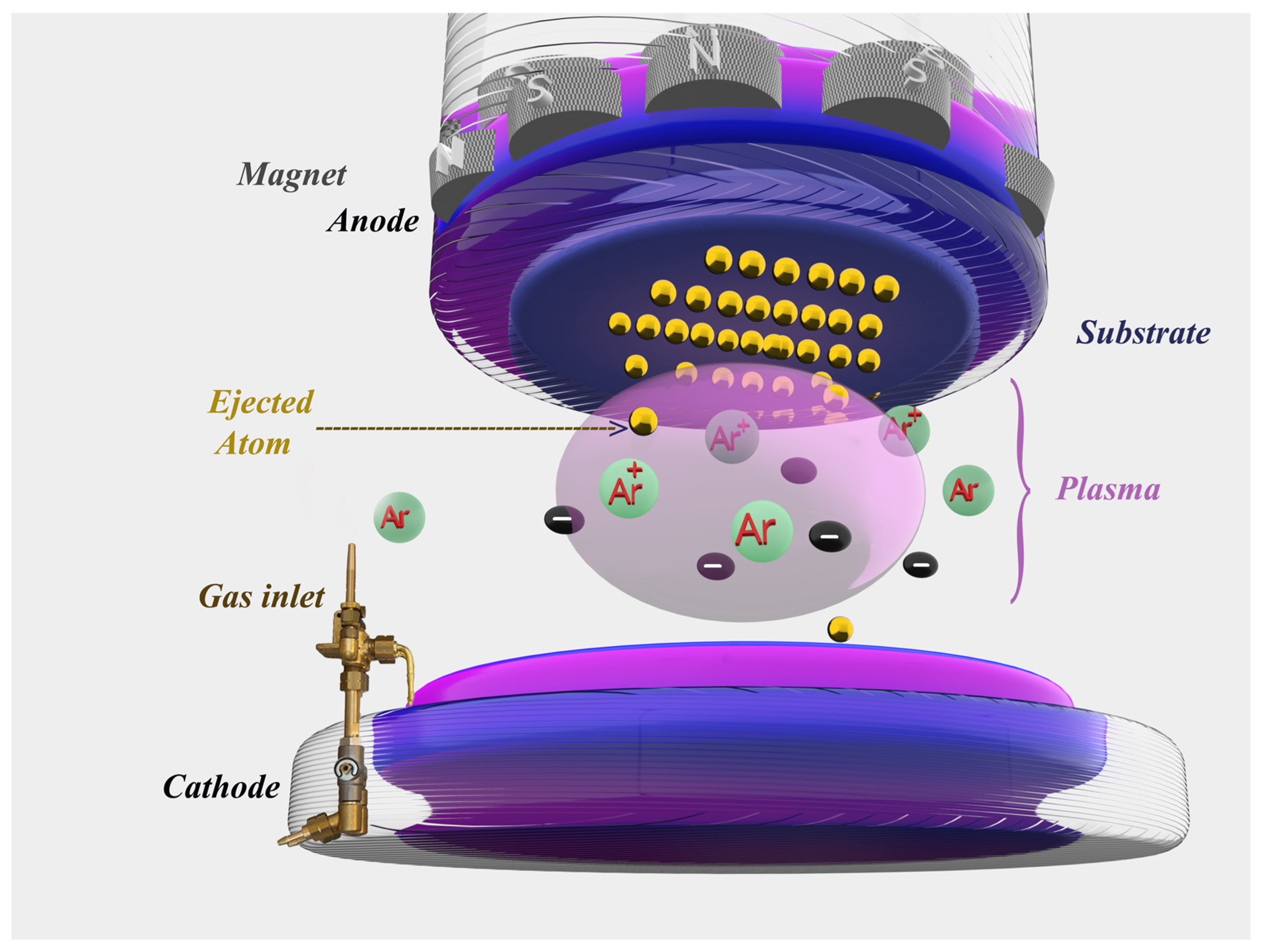
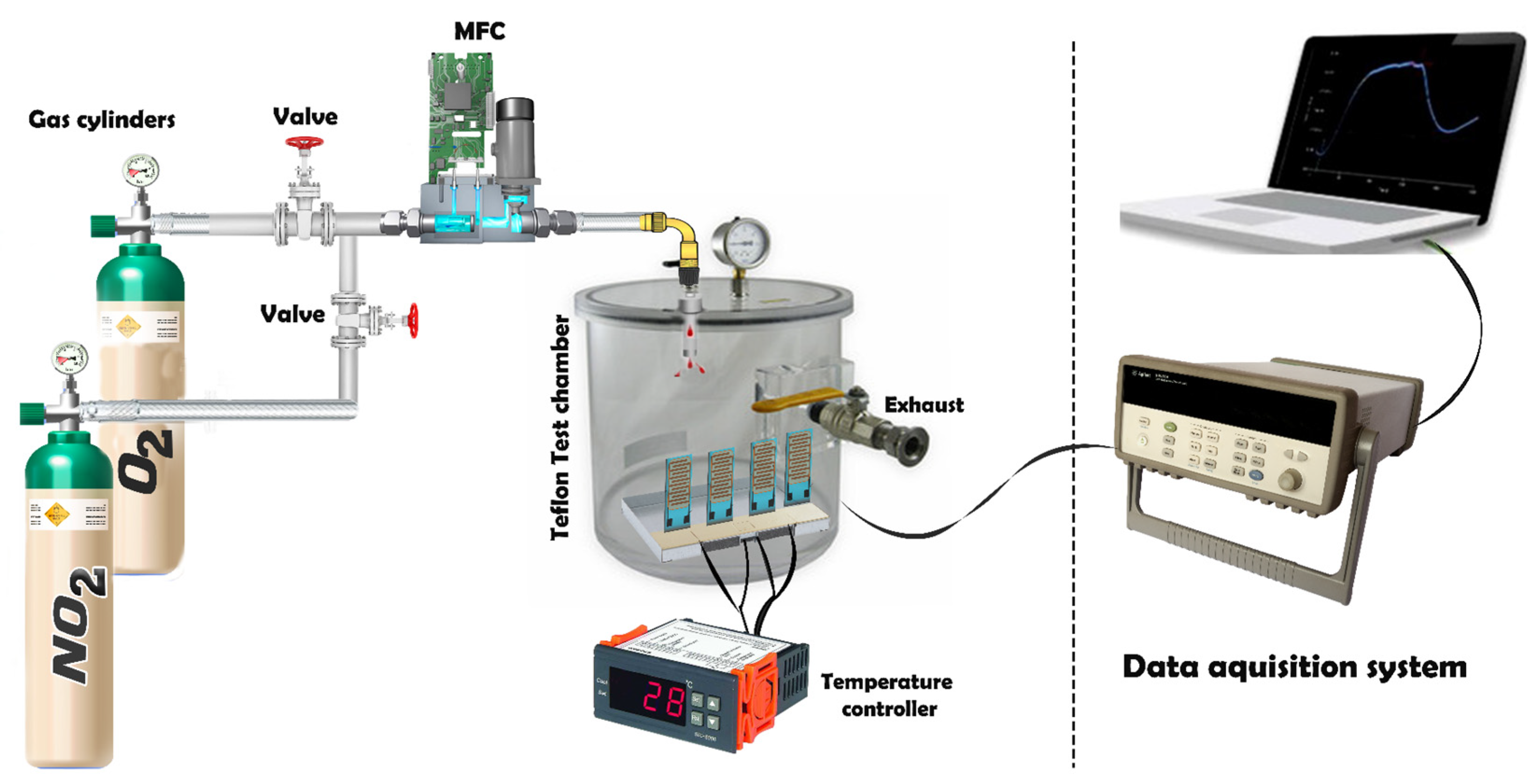
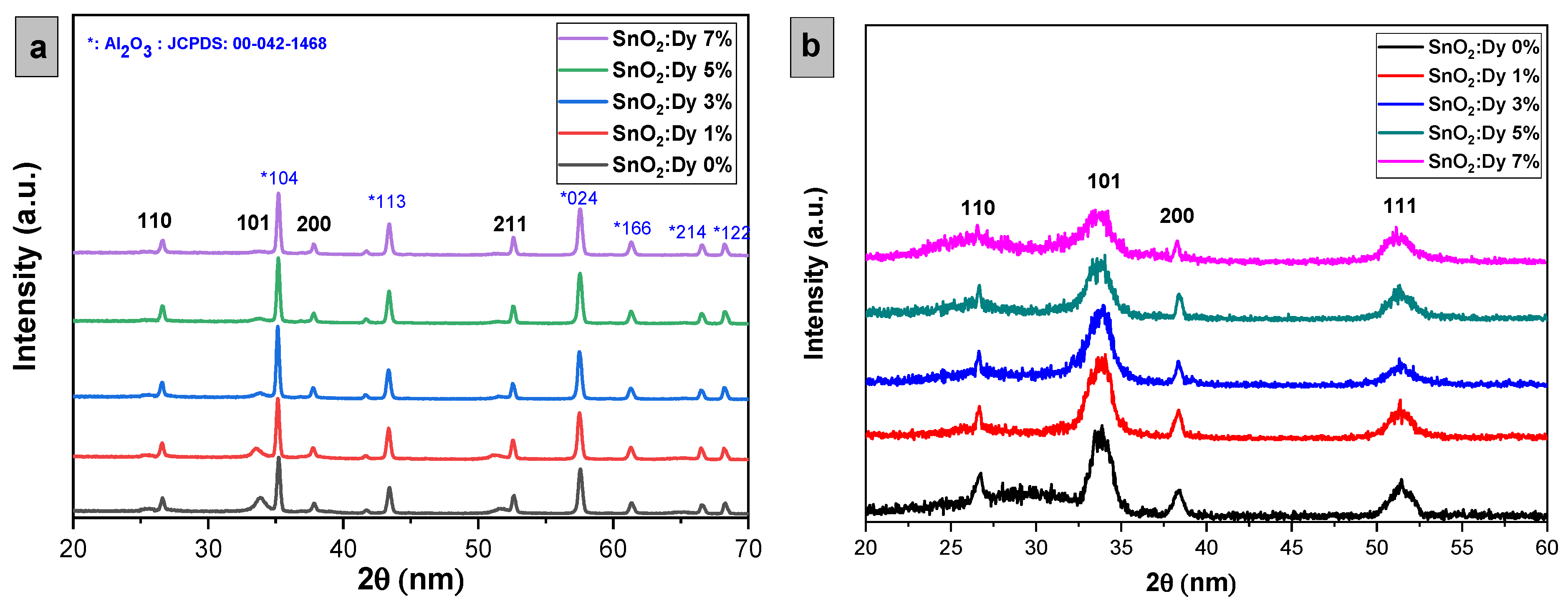
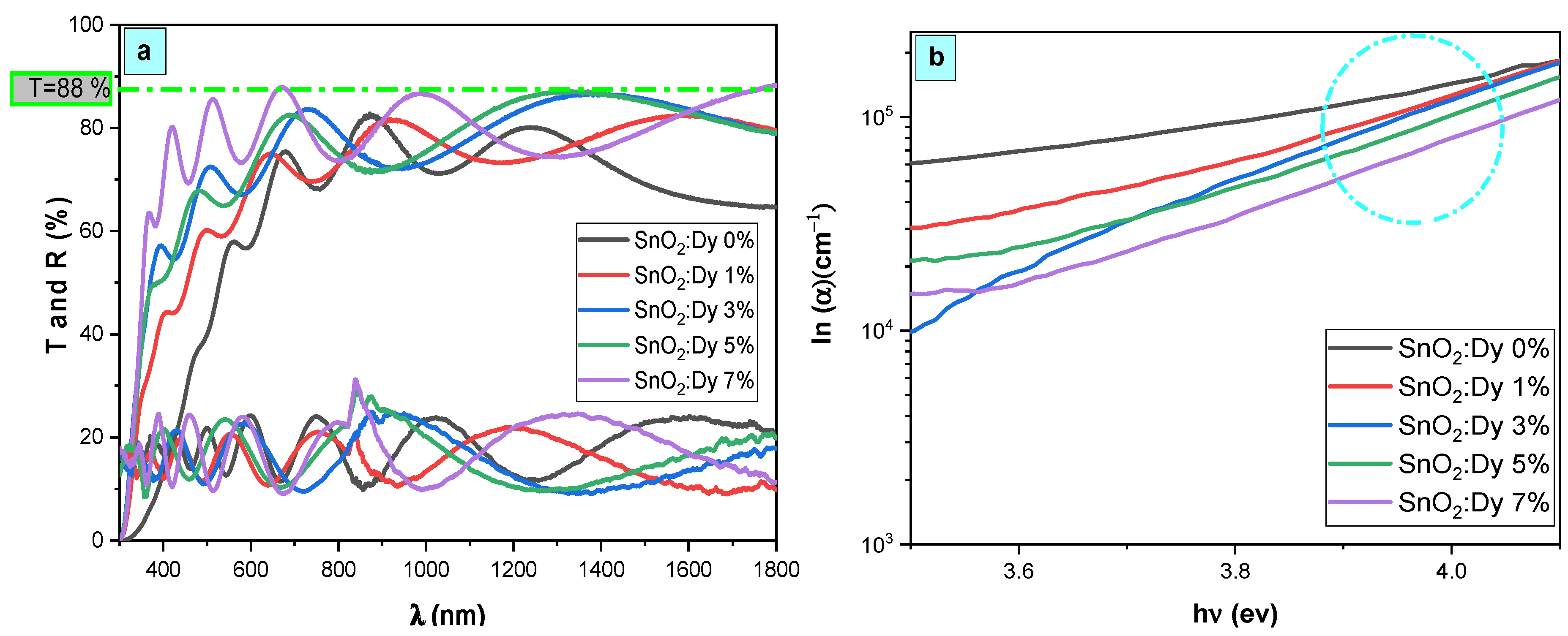
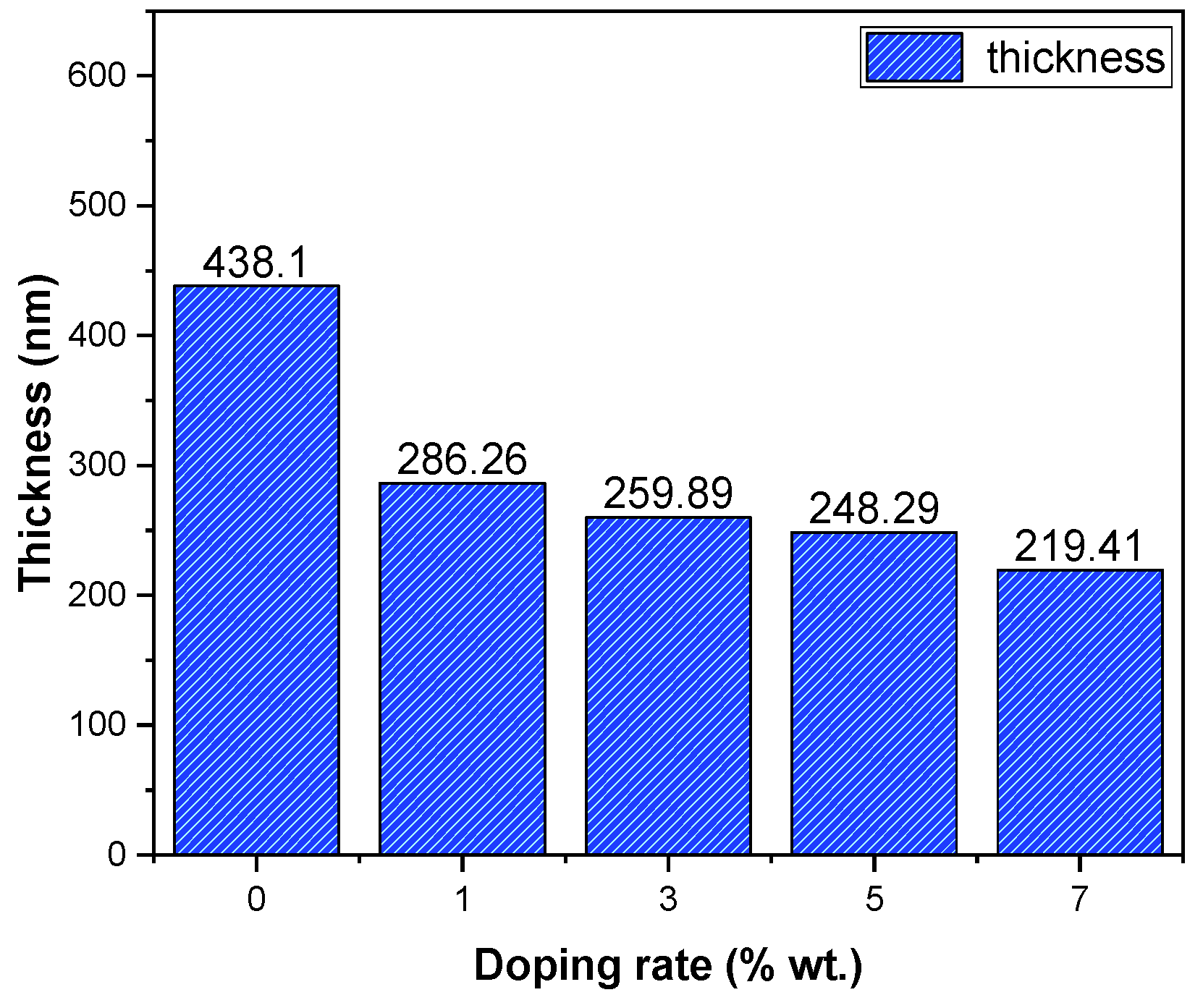
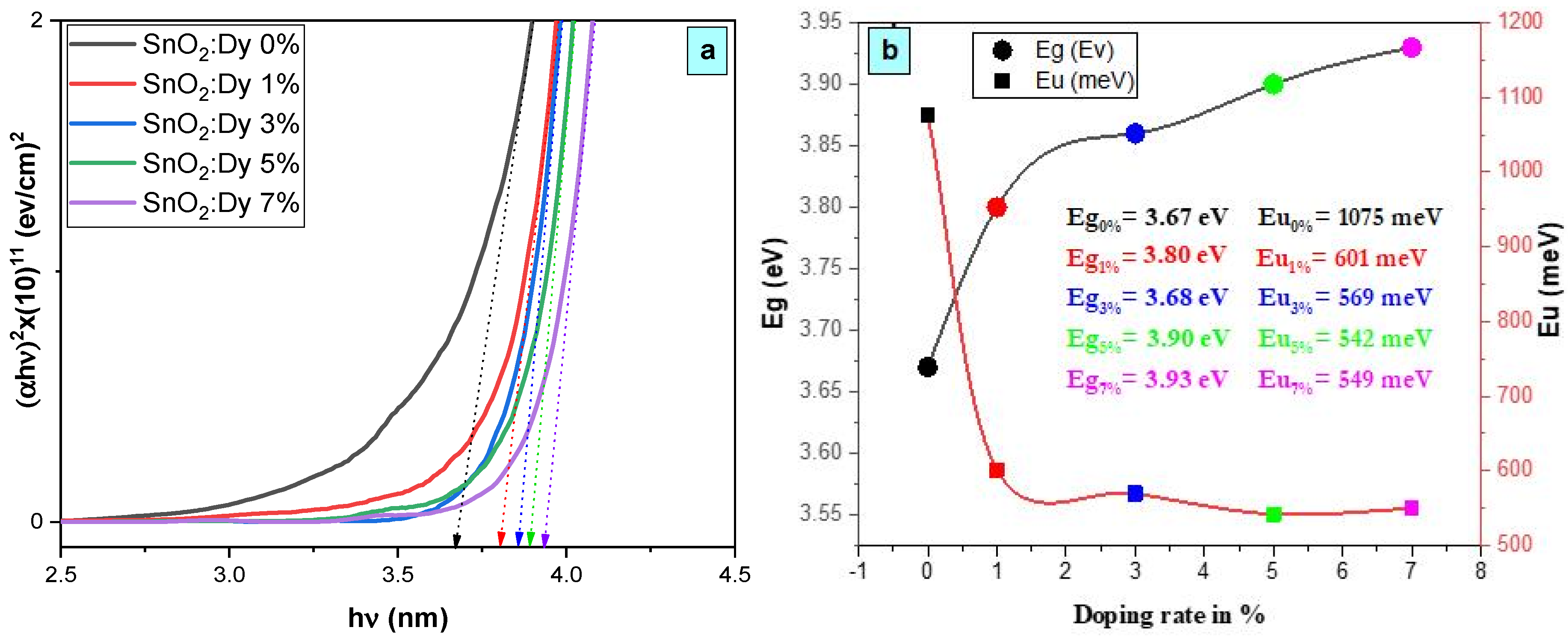

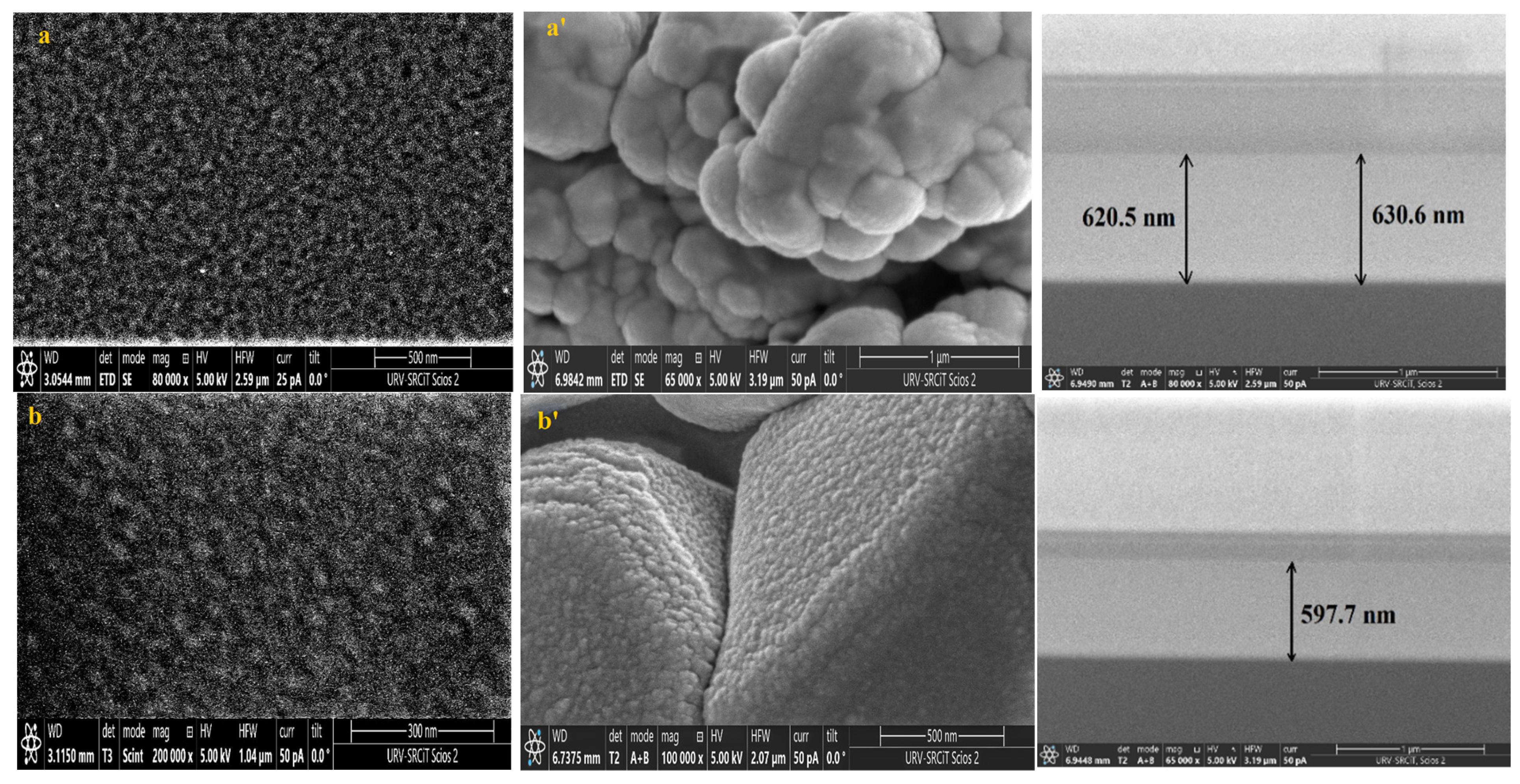
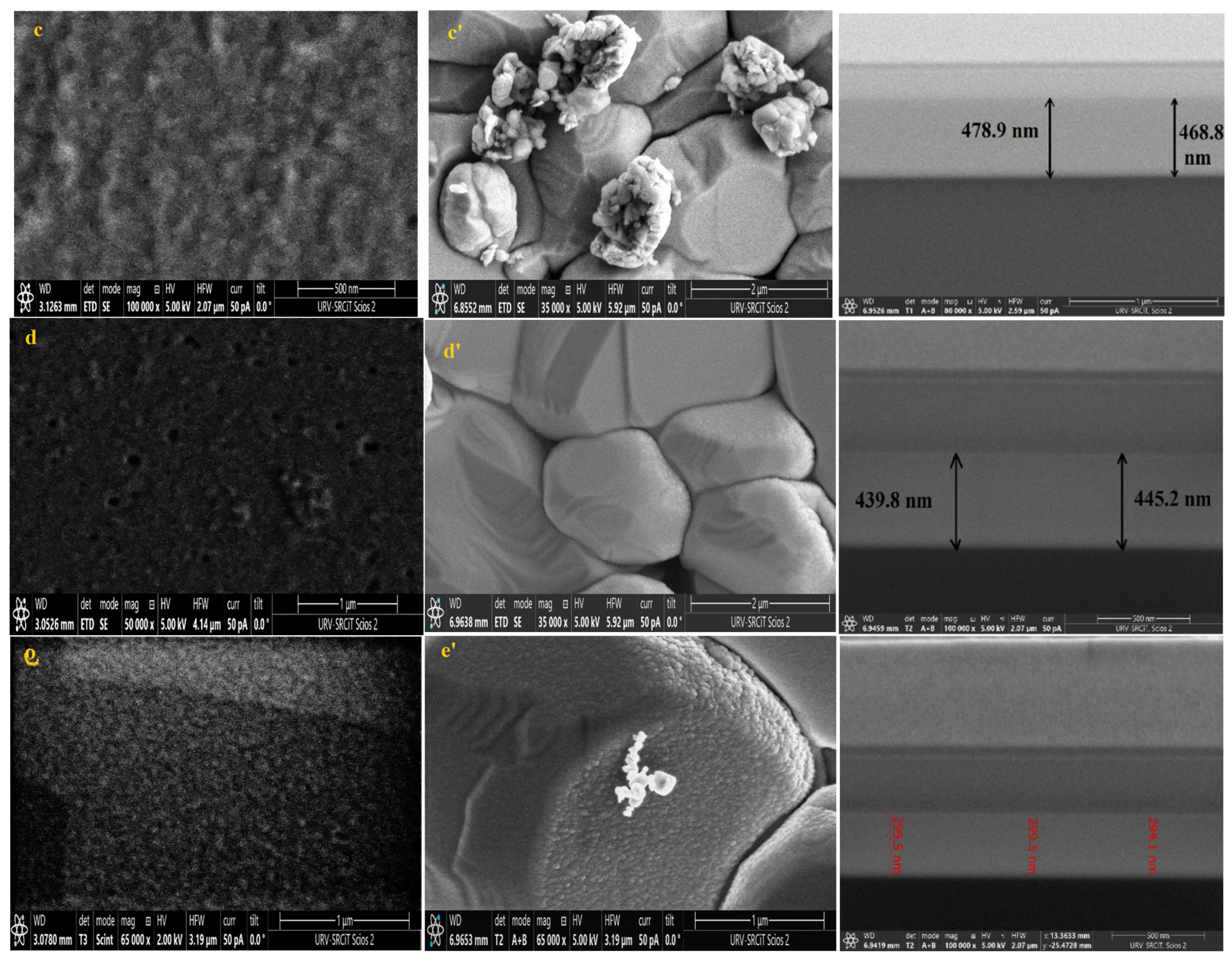
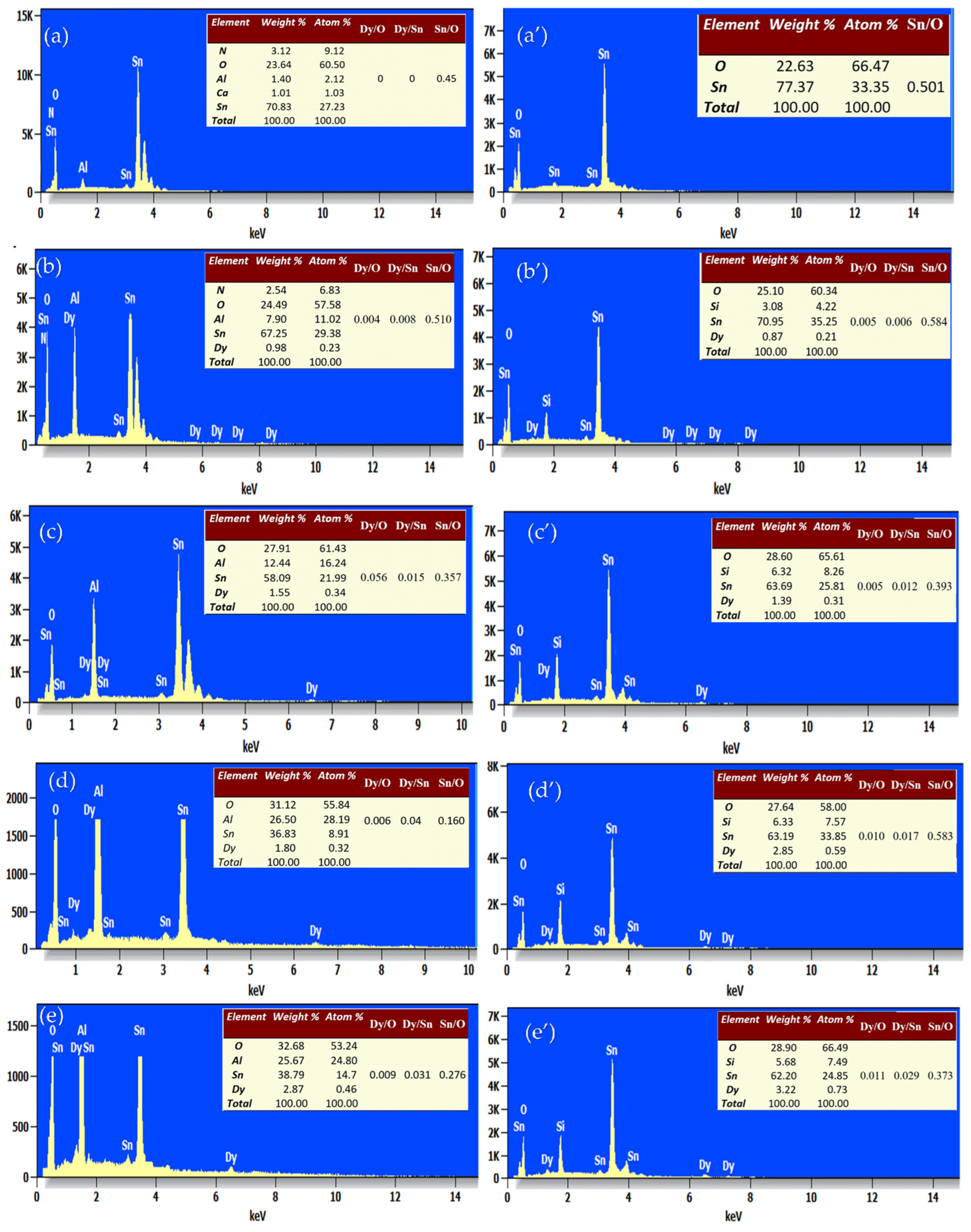
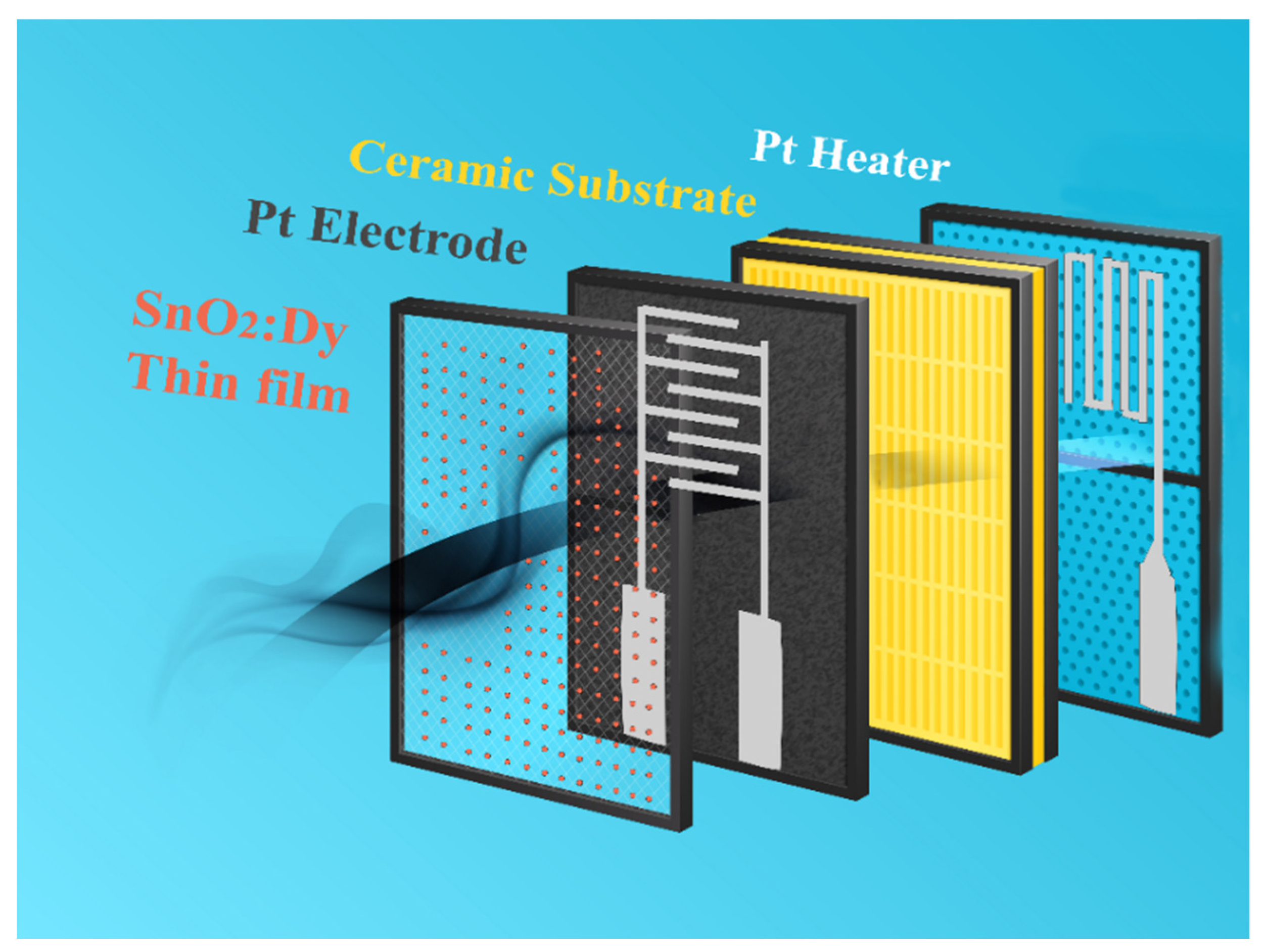
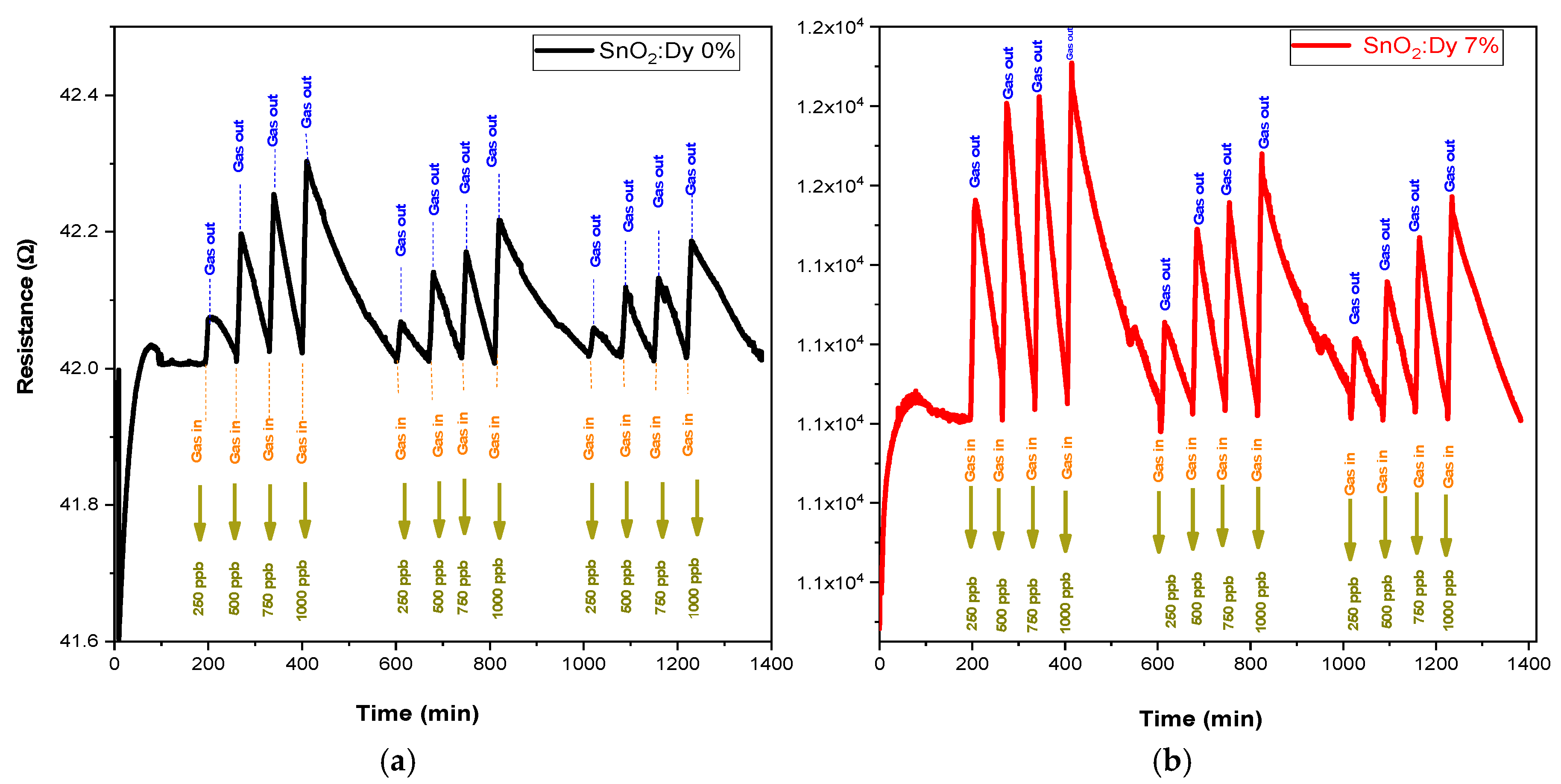
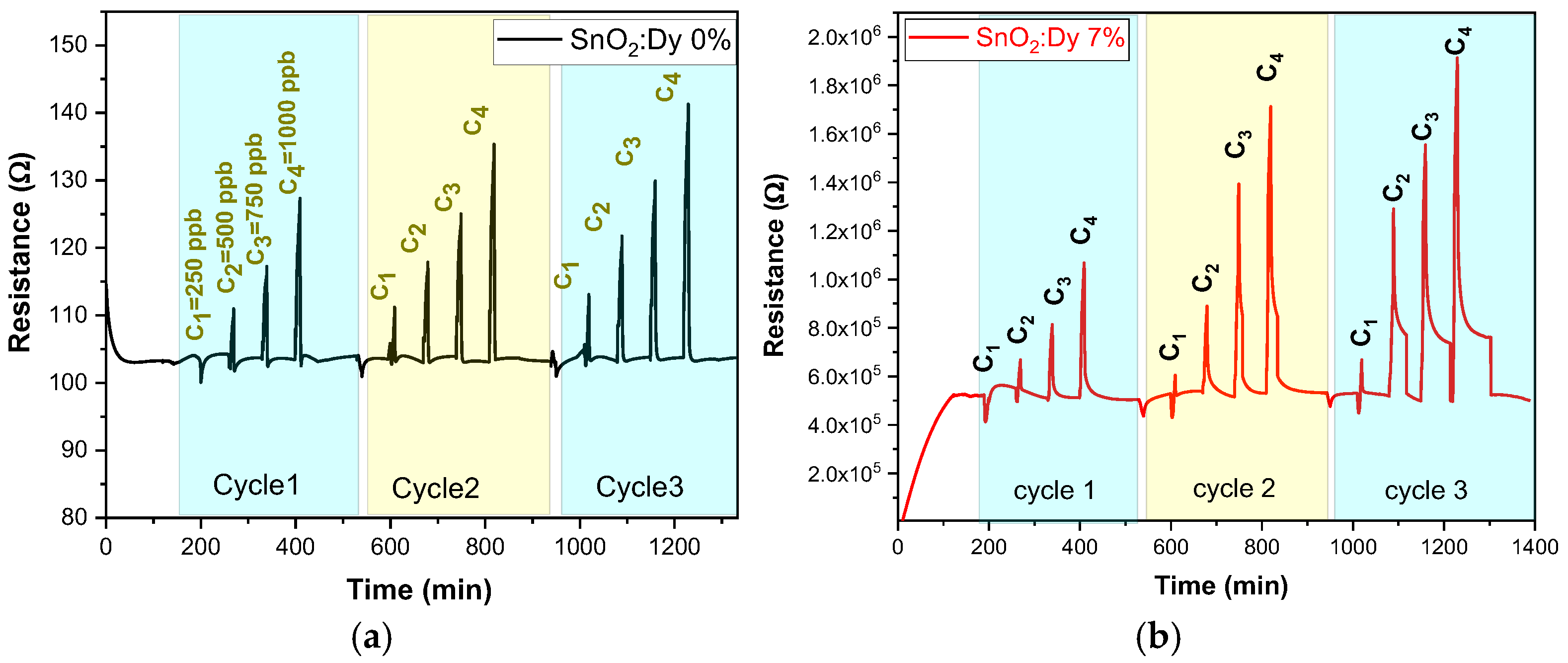
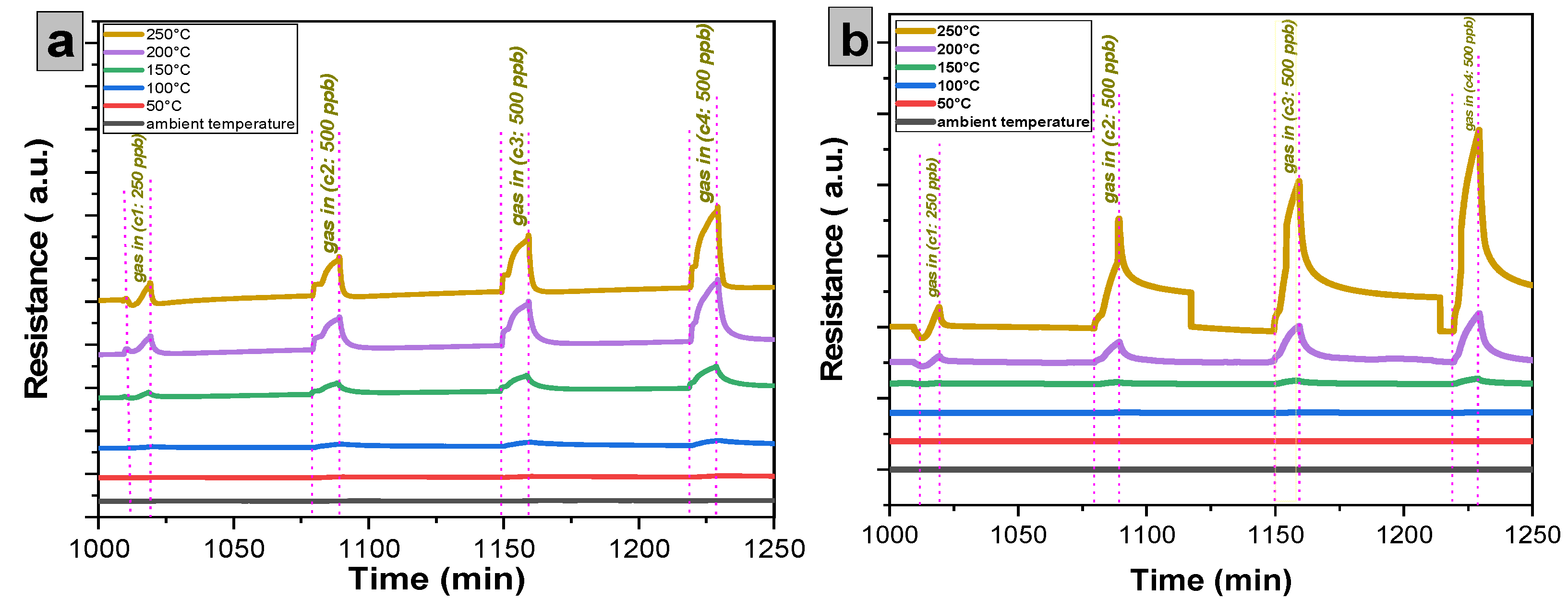



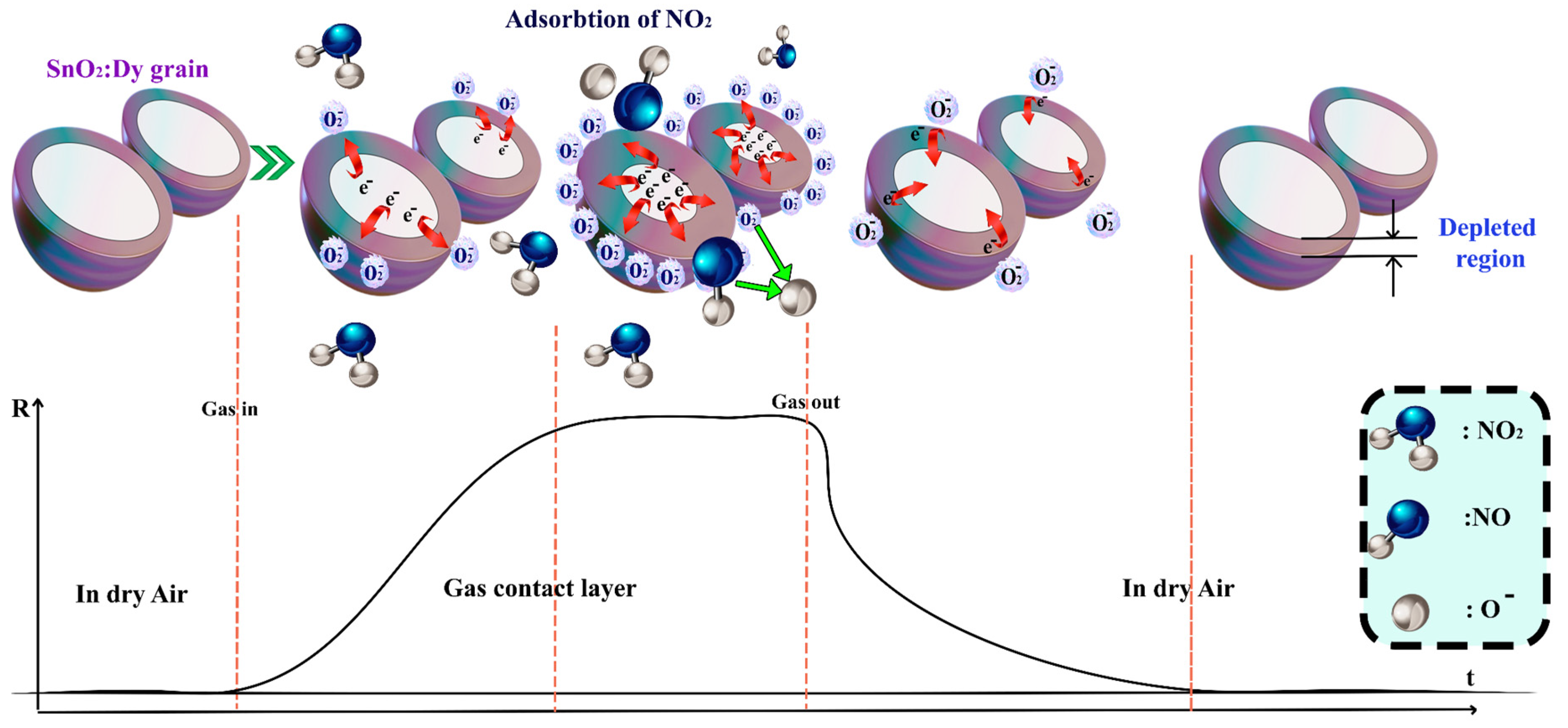
| SnO2:Dy Thin Films Deposited on Alumina Substrates | |||||||||
|---|---|---|---|---|---|---|---|---|---|
| Samples | (hkl) | 2θ (°) | dhkl (A°) | a (A°) | c (A°) | D (nm) | δ·10−3 (nm−2) | ε·(10−3) (rad) | Tc(101) |
| SnO2:Dy 0% | (110) | 26.68 | 3.34 | 4.72 | 2.64 | 5.55 | 3.24 | 6.24 | 0.54 |
| SnO2:Dy 1% | (110) | 26.68 | 3.34 | 4.72 | 2.66 | 5.10 | 3.84 | 6.79 | 0.68 |
| SnO2:Dy 3% | (110) | 26.62 | 3.34 | 4.73 | 2.65 | 4.98 | 4.04 | 6.96 | 0.60 |
| SnO2:Dy 5% | (110) | 26.62 | 3.34 | 4.73 | 2.65 | 5.01 | 3.99 | 6.92 | 0.75 |
| SnO2:Dy 7% | (110) | 26.54 | 3.36 | 4.74 | 2.65 | 4.08 | 6.00 | 8.49 | 0.57 |
| SnO2:Dy Thin Films Deposited on Glass Substrates | |||||||||
|---|---|---|---|---|---|---|---|---|---|
| Samples | (hkl) | 2θ (°) | dhkl (A°) | a (A°) | c (A°) | D (nm) | δ·10−3 (nm−2) | ε·(10−3) (rad) | Tc(101) |
| SnO2:Dy 0% | (110) | 26.68 | 3.34 | 4.72 | 2.64 | 5.55 | 6.24 | 0.54 | 2.85 |
| SnO2:Dy 1% | (110) | 26.68 | 3.34 | 4.72 | 2.66 | 5.10 | 6.79 | 0.68 | 2.54 |
| SnO2:Dy 3% | (110) | 26.68 | 3.34 | 4.73 | 2.65 | 4.98 | 6.96 | 0.60 | 2.93 |
| SnO2:Dy 5% | (110) | 26.68 | 3.34 | 4.73 | 2.65 | 5.01 | 6.92 | 0.75 | 1.89 |
| SnO2:Dy 7% | (110) | 26.68 | 3.36 | 4.74 | 2.65 | 4.08 | 8.49 | 0.57 | 2.05 |
| RMS (nm) | ||
|---|---|---|
| Substrate Type | Glass | Alumina |
| pure SnO2 | 5.88 | 449.1 |
| 1% Dy | 1.69 | 552.2 |
| 3% Dy | 1.14 | 412.8 |
| 5% Dy | 1.14 | 431.8 |
| 7% Dy | 0.94 | 308.9 |
| Glass Substrates | |||
|---|---|---|---|
| Thin Film | Sheet Resistance | Resistivity (Ohms cm) | Conductivity Ohms cm−1 |
| Pure SnO2 | 4.21 × 102 | 2.10 × 10−2 | 4.75 × 101 |
| SnO2:Dy 1% | 8.52 × 102 | 4.26 × 10−2 | 2.35 × 101 |
| SnO2:Dy 3% | 2.26 × 103 | 1.13 × 10−1 | 8.85 |
| SnO2:Dy 5% | 4.24 × 103 | 2.12 × 10−1 | 4.714 |
| SnO2:Dy 7% | 5.73 × 105 | 2.87 × 101 | 3.49 × 10−2 |
| Alumina Substrates | |||
| Thin Film | Sheet Resistance | Resistivity (Ohms cm) | Conductivity Ohms cm−1 |
| Pure SnO2 | 40.1 | 2.40 × 10−3 | 4.17 × 102 |
| SnO2:Dy 1% | 1.2 × 102 | 5.6 × 10−3 | 1.79 × 102 |
| SnO2:Dy 3% | 3.21 × 102 | 1.44 × 10−2 | 6.94 × 101 |
| SnO2:Dy 5% | 4.05 × 103 | 1.41 × 10−1 | 7.09 |
| SnO2:Dy 7% | 6.06 × 103 | 1.81 × 10−1 | 5.53 |
| Room Temperature | Ambient Temperature | 250 °C | |||||
|---|---|---|---|---|---|---|---|
| Response Time (Rt) (min) | Recovery Time (Rc) (min) | LOD (ppb) | Response Time (Rt) (min) | Recovery Time (Rc) (min) | LOD (ppb) | ||
| SnO2:Dy 0% | 9.25 | 116 | 198.77 | 8.5 | 1 | 109.46 | |
| SnO2:Dy 7% | 9 | 101 | 172.26 | 9 | 5.55 | 122.7 | |
| Structure | Target Gas | Studied Concentration (ppm) | Working Temperature (°C) | Response Intensity | Rt (s) | Rc (s) | LOD (ppb) | References |
|---|---|---|---|---|---|---|---|---|
| Graphene-decorated SnO2 nanoparticles | NO2 | 10 | RT | 1.25 | 20 | 41 | --- | [55] |
| SnO2/rGO aerogel | NO2 | 50 | RT | 1.76 | 8 | 13 | <1 | [56] |
| Ni-doped SnO2 nanoparticles | NO2 | 100 | 200 | 40% | 6 | 115 | --- | [57] |
| SnO2:MCs | NO2 | 4.5 | 230 | 25.7% | 1 | 59 | --- | [58] |
| SnO2:Dy | Ethanol | 2000 | 300 | 92% | 16 | 30 | --- | [24] |
| SnO2:Dy | Ethanol | 100 | 200 | 120% | --- | --- | --- | [23] |
| SnO2:Dy | LPG | 500 | 350 | 100% | 7 | --- | --- | [59] |
| SnO2:rGO | NO2 | 80 | RT | 2.9 | 5.6 | 14.1 | 209 | [60] |
| SnO2:Dy | NO2 | 0.25 to 1 | 250 | 7.2% to 42.47% | 9 min | 1 min to 5.5 min | 109.46 to 122.7 | This work |
Disclaimer/Publisher’s Note: The statements, opinions and data contained in all publications are solely those of the individual author(s) and contributor(s) and not of MDPI and/or the editor(s). MDPI and/or the editor(s) disclaim responsibility for any injury to people or property resulting from any ideas, methods, instructions or products referred to in the content. |
© 2025 by the authors. Licensee MDPI, Basel, Switzerland. This article is an open access article distributed under the terms and conditions of the Creative Commons Attribution (CC BY) license (https://creativecommons.org/licenses/by/4.0/).
Share and Cite
Mezyen, M.; Bitri, N.; Riahi, I.; Chaabouni, F.; Llobet, E. Optimizing Sputtered SnO2:Dy Thin Films for NO2 Gas Detection. Chemosensors 2025, 13, 121. https://doi.org/10.3390/chemosensors13040121
Mezyen M, Bitri N, Riahi I, Chaabouni F, Llobet E. Optimizing Sputtered SnO2:Dy Thin Films for NO2 Gas Detection. Chemosensors. 2025; 13(4):121. https://doi.org/10.3390/chemosensors13040121
Chicago/Turabian StyleMezyen, Marwen, Nabila Bitri, Ibtissem Riahi, Fatma Chaabouni, and Eduard Llobet. 2025. "Optimizing Sputtered SnO2:Dy Thin Films for NO2 Gas Detection" Chemosensors 13, no. 4: 121. https://doi.org/10.3390/chemosensors13040121
APA StyleMezyen, M., Bitri, N., Riahi, I., Chaabouni, F., & Llobet, E. (2025). Optimizing Sputtered SnO2:Dy Thin Films for NO2 Gas Detection. Chemosensors, 13(4), 121. https://doi.org/10.3390/chemosensors13040121






